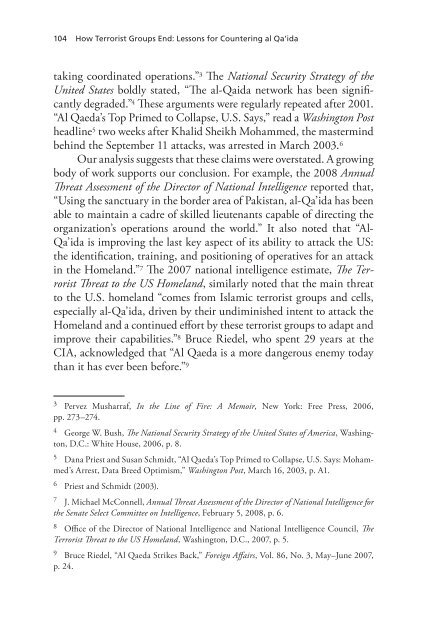How Terrorist Groups End - RAND Corporation
How Terrorist Groups End - RAND Corporation
How Terrorist Groups End - RAND Corporation
Create successful ePaper yourself
Turn your PDF publications into a flip-book with our unique Google optimized e-Paper software.
104 <strong>How</strong> <strong>Terrorist</strong> <strong>Groups</strong> <strong>End</strong>: Lessons for Countering al Qa’ida<br />
taking coordinated operations.” 3 The National Security Strategy of the<br />
United States boldly stated, “The al-Qaida network has been significantly<br />
degraded.” 4 These arguments were regularly repeated after 2001.<br />
“Al Qaeda’s Top Primed to Collapse, U.S. Says,” read a Washington Post<br />
headline 5 two weeks after Khalid Sheikh Mohammed, the mastermind<br />
behind the September 11 attacks, was arrested in March 2003. 6<br />
Our analysis suggests that these claims were overstated. A growing<br />
body of work supports our conclusion. For example, the 2008 Annual<br />
Threat Assessment of the Director of National Intelligence reported that,<br />
“Using the sanctuary in the border area of Pakistan, al-Qa’ida has been<br />
able to maintain a cadre of skilled lieutenants capable of directing the<br />
organization’s operations around the world.” It also noted that “Al-<br />
Qa’ida is improving the last key aspect of its ability to attack the US:<br />
the identification, training, and positioning of operatives for an attack<br />
in the Homeland.” 7 The 2007 national intelligence estimate, The <strong>Terrorist</strong><br />
Threat to the US Homeland, similarly noted that the main threat<br />
to the U.S. homeland “comes from Islamic terrorist groups and cells,<br />
especially al-Qa’ida, driven by their undiminished intent to attack the<br />
Homeland and a continued effort by these terrorist groups to adapt and<br />
improve their capabilities.” 8 Bruce Riedel, who spent 29 years at the<br />
CIA, acknowledged that “Al Qaeda is a more dangerous enemy today<br />
than it has ever been before.” 9<br />
3 Pervez Musharraf, In the Line of Fire: A Memoir, New York: Free Press, 2006,<br />
pp. 273–274.<br />
4 George W. Bush, The National Security Strategy of the United States of America, Washington,<br />
D.C.: White House, 2006, p. 8.<br />
5 Dana Priest and Susan Schmidt, “Al Qaeda’s Top Primed to Collapse, U.S. Says: Mohammed’s<br />
Arrest, Data Breed Optimism,” Washington Post, March 16, 2003, p. A1.<br />
6 Priest and Schmidt (2003).<br />
7 J. Michael McConnell, Annual Threat Assessment of the Director of National Intelligence for<br />
the Senate Select Committee on Intelligence, February 5, 2008, p. 6.<br />
8 Office of the Director of National Intelligence and National Intelligence Council, The<br />
<strong>Terrorist</strong> Threat to the US Homeland, Washington, D.C., 2007, p. 5.<br />
9 Bruce Riedel, “Al Qaeda Strikes Back,” Foreign Affairs, Vol. 86, No. 3, May–June 2007,<br />
p. 24.

















